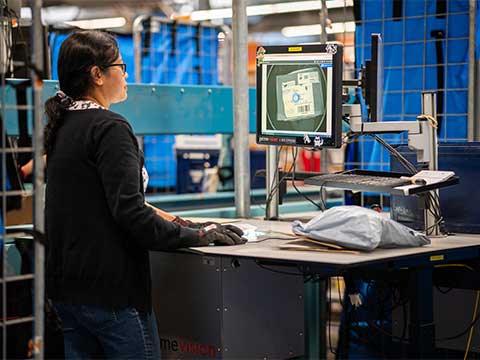
Posted to News on 12th Apr 2024, 15:00
Anything to declare? Ensuring efficiency in cross-border logistics
Hans Jongebloed, innovation manager at Prime Vision, looks at the challenges facing international sellers and how optical character recognition (OCR) and artificial intelligence (AI) can help ensure cross-border efficiency.

In our globalised economy, an incredible volume of goods crosses international borders every day. While displaying key information on parcels is essential for clearing customs, many countries are tightening regulations to stop fraudulent, dangerous and illegal goods entering their markets. In most cases, sellers are now required to submit parcel data to customs or postal services before sending, but providing this can be costly and time consuming.
International trade presents nations with a big security issue. With such high volumes of parcels entering the country, it can be difficult to effectively scan or search them for prohibited items. Holding up every international order to conduct these checks is not feasible, so many nations are switching to a pre-arrival model.
To this end, the European Union (EU) is implementing its Import Control System 2 (ICS2), which will require traders to send data to customs before a parcel arrives in the EU. The new regulations aim to adequately manage risks while still promoting the free flow of goods between the bloc and the rest of the world. Now, if a parcel is sent to the EU without data submitted beforehand, it will bounce back to the sender.
Sellers submitting data
Putting data on parcels via labels and tables is nothing new to international sellers, submitting it to the right place prior to arrival is though.
Traders must provide data regarding the receiver and sender of the parcel, including name and contact details such as address and telephone number. A short description of what the package contains is required too, along with a Harmonised System (HS) 6-digit code that identifies every product and the material it is made of. This is particularly useful for labelling items that could be potentially hazardous, like those with lithium-ion batteries. The weight, number of objects and the price per item are also needed, as well as the country of origin. For larger parcels even more data is required.
Clearly this is a lot to process, even for a smaller business. Submitting this information manually via data entry can be extremely time consuming and costly - or even impossible for companies sending higher parcel volumes - so sellers require a different approach to safeguard efficiency.
Recognising a more intelligent approach
Ultimately, the optimal approach is to digitise data gathered from parcel labels as they pass through the sorting process. A camera placed above a conveyor or tabletop, equipped with OCR technology can read each label, collecting individual parcel data and automatically transforming it into a pre-arrival submission, ready to be forwarded to postal services or customs.
Before implementation, OCR must be fed a sufficient amount of labels and parcels to train the AI models that power it. With enough examples, AI can not only decipher parcel information, but even reconstruct damaged labels and reduce no reads. This doesnt just apply to machine printed labels AI can also read handwriting and turn it into digital data. In all cases, the OCR system is directly integrated with the customers existing IT or warehouse management system, providing seamless sharing of information and easy generation of pre-arrival submissions.
For high-volume operations, companies with small administration capacity or those handling parcels coming from varied departments and suppliers this is a highly effective way to ensure cross-border efficiency without the disadvantages of manual data entry.
A standardised solution for the future
Until recently, OCR systems were the preserve of businesses dealing with high parcel volumes. In fact, many early implementations were more akin to research and development projects, with large investment required to train the AI and achieve a suitable solution.
Today, things are different. Prime Vision offers a proven, out-the-box OCR system at a competitive cost point. Developed and fine-tuned to support global e-commerce companies and national postal services, standardised Customs Vision products are backed by highly trained AI models that can quickly and flexibly adapt to the idiosyncrasies of customer operations.
Consequently, very little development work is required, speeding up implementation and reducing cost. Rather than remaining the preserve of the big players, OCR is now accessible and economic for logistics operations of all shapes and sizes.
Keeping ahead of regulation
Managing the risks of free trade is an ongoing process for nations and their customs authorities. Measures similar to ICS2 are already in effect in countries such as the US, and global adoption is set to grow. However, by harnessing OCR technology with the expert guidance of companies like Prime Vision, international sellers can seamlessly meet the latest customs data requirements and ensure that everything is declared.


















